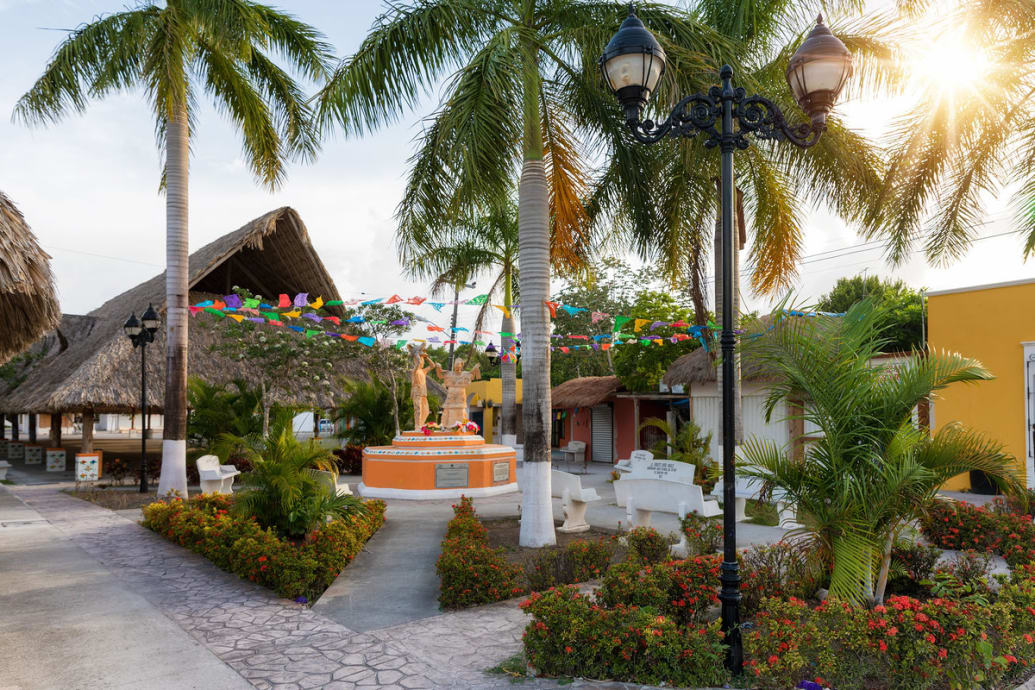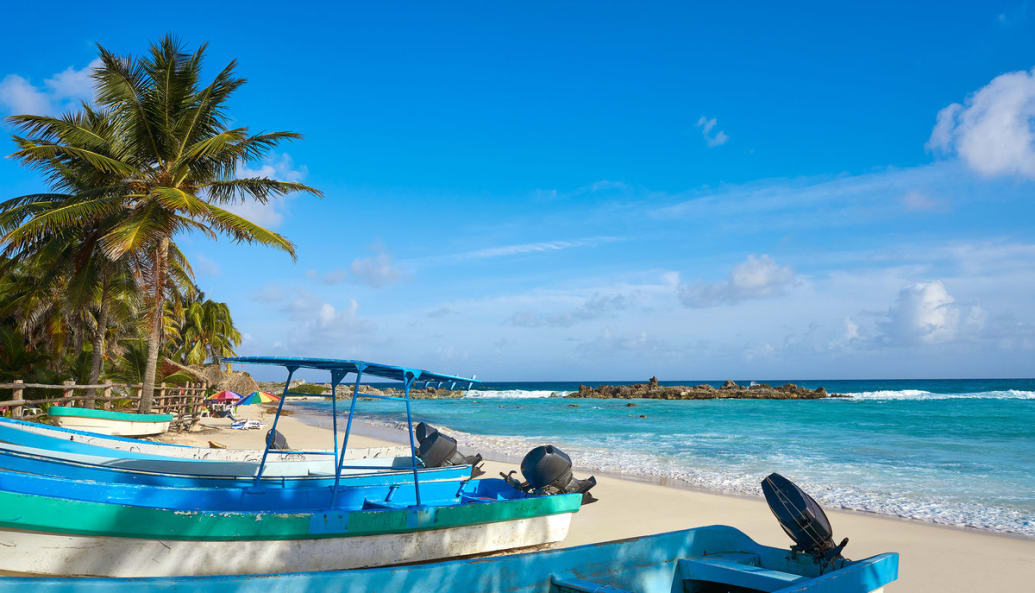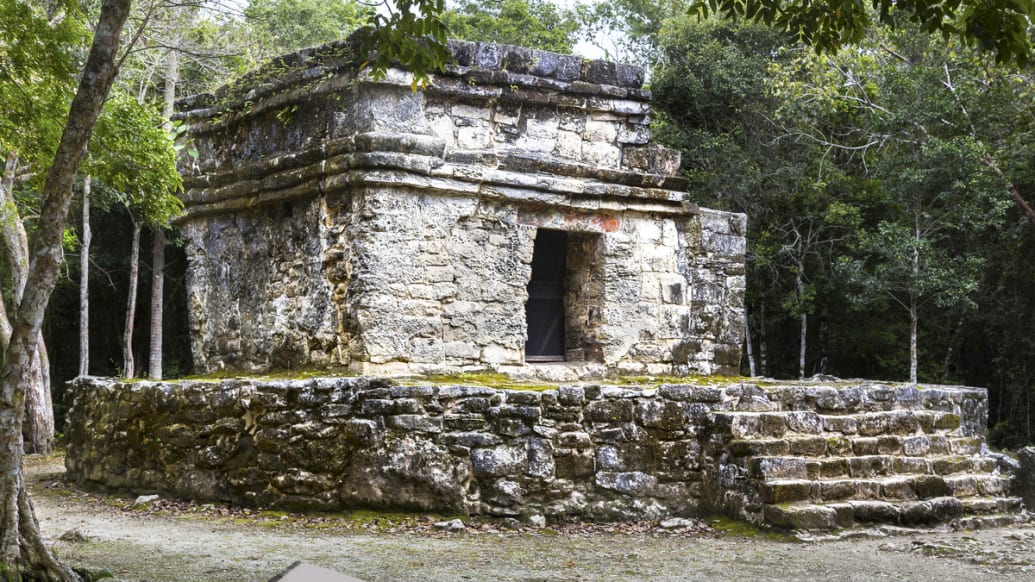It’s an hour before first light on the island of swallows, and the streets of downtown San Miguel de Cozumel are a silent black. We pass the hotels, empty cruise ports, and dive shops, and head north on this Mayan isle.
It doesn’t take long to get into the wild at this hour. We turn onto the dirt road slowly, and the Jeep Renegade rocks through massive dips filled with sulfuric water. There are no houses, no hotels. Just stars, mud, and the early morning chants of crickets and songbirds.
After about 20 minutes of slowly maneuvering through the deeply pocked road, we arrive at stillness, the deep blues of the night sky giving way to a bright sunrise, and the gentle lapping of brackish water against the shore.
Rafa Chacón, a biologist and Cozumel native, meets us here. He’s getting the canoes ready for a group of local families and some tourists for a morning of mangrove reforestation. His organization, Endémicos Cozumel, is dedicated to the preservation of Cozumel’s unique ecosystem against constant and increasing threats of predatory tourism and climate change.

Mangrove reforestation on Isla de la Pasión.
Megan Frye
As wild as much of its 185 square miles is, Cozumel is not a place particularly known for adventure tourism, aside from its famed scuba diving. Most visitors will arrive on a cruise ship, with up to 100,000 passengers per week spilling into its western ports, hustled into shops selling tequila shooters and gold, whisked onto scooters few of them know how to operate, Cozumel’s cruise port culture, like most others in the Caribbean, is a hot mess. Which perhaps makes it all the more rewarding to know how to get away from it. There’s so much that the masses just don’t know about Cozumel, its conservation story included.
It’s still cool out as we paddle across the lagoon, toward Isla de la Pasión, a white sandy beach facing the inland waters on one side and the bright Caribbean on the other. We maneuver through tangled mangroves to where we’ll plant mangrove seeds, directly into the sand.
“Cozumel is a sanctuary for the natural world,” Chacón says, as he hands out mangrove seedlings to the reforestation crew. “Cozumel is a unique place that is ours to protect, and we must because there is no other place like it in the world. Ecosystems such as this are very fragile. When people come to Cozumel, they need to know what it is that they are seeing and experiencing. It’s not just about sun and beach, but also the value of the ecosystem.”
The mangrove seeds are long and pointed, and dig easefully into the white sand, where they’ll reach more than six-feet tall in two years. Mangroves reduce ocean swells and winds that can cause flooding and erosion. But when hurricanes pass through, such as Grace did last year, the mangroves are disturbed, sometimes destroyed, and need to be replanted.
As the morning gets warmer, the serenity of the lagoon is interrupted by a speeding boat carrying at least a dozen cruise ship revelers to a remote bar, not far from the reforestation project. Loud pop music begins to sound from the speakers at the bar, and the subtle chatter of nature is quickly overpowered. The boat returns empty after a few minutes, the driver heading back toward the cruise port to pick up more guests.
“He’s going too fast,” says Chacón, unsurprised, as he continues to clear the beach of tiny pieces of plastic, bottle caps, a toothbrush; a common sight on any coast in today’s world of excess.
The building of a super port
Known for its incredible snorkeling and diving, Cozumel (with a permanent population of about 100,000) has millennia of history as a sacred site for the local Mayan population, from whom it gets its nickname “island of swallows.” It has attracted tourists in droves since at least the ’60s, with a massive increase in the following decade as nearby Cancun’s new international airport began to bring in travelers from around the globe.
The island has three piers already and plans are underway to build a fourth to receive even more cruises per week, despite a long battle between conservationists, locals, and the cruise ship industry. Cozumel has a prized position on the Mesoamerican reef: the second largest coral reef system in the world following Australia’s Great Barrier Reef. It stretches from north of Cozumel past the coasts of Belize and Guatemala and along the coast of Honduras.
Environmentalists argue that the piers and the massive ships destroy the very reefs that people come to dive and snorkel, a massive generator of sustainable tourism. Eventually, Chacón says, when the reefs have died, the divers will go elsewhere to places where they’ve been protected, where they are full of life.
Most of Cozumel’s famous tourist attractions, bars, and restaurants are on the west side of the island, with spectacular sunsets overlooking Playa del Carmen and the now overdeveloped Riviera Maya.
The South, the North, and the East, however, are scarcely visited unless people know where they are going. The same with the central portion of the island, which is made up largely of ejido land—a term referring to the agricultural reform following the Mexican Revolution, which gave land to native peoples of Mexico.
Visiting off-the-beaten path parts of the island such as Punta Sur Ecological Park for star and crocodile gazing, Punta Molas Lighthouse, and the small town of El Cedral and nearby Mayan archaeological site San Gervasio are ways that travelers can help contribute to the local community, as well as be amazed by what it has to offer. Birding trails around El Cedral as well as at the tip of Isla Pasión are great for sighting rare migratory and endemic species alike.

932176502
The small, old Mayan village El Cedral on Cozumel island, Quintana Roo, Mexico
Getty Images
Renting a four-wheel-drive vehicle is the best bet for accessing the wilder parts of the island. Some places are only accessible by boat, such as the Cozumel Pearl Farm, which boasts itself as the only working pearl farm in the Caribbean. World-class diving and snorkeling opportunities abound.
The other side of Cozumel is local. It’s wild. It’s concerned and invested in protecting its wilderness.
Calling Cozumel home
My first sight of Nacho Gutiérrez, the unequivocal king of Cozumel surf, is as he pushes his dog on his surfboard, into the whitewater at Playa Chen Río, a wild expanse of beach on the eastern edge of the island.

912490020
Chen Rio beach
Getty Images
Originally from the neighboring state of Yucatán, Gutiérrez has spent most of his life on Cozumel, arriving with family as a young boy. I was surprised to see waves like this on this part of the Caribbean, as just nine miles across the island, the water is smooth—part of what has made Riviera Maya the tropical paradise it’s been sold as.
As the founder of Cozumel Surfing School, Gutiérrez says Cozumel lacks the kind of tourism that comes and stays on the island, referred to as “per nocta” tourism in the hotel industry. Prior to the competition of cruise ships, hotel rooms were nearly always full.
“The cruise ships bring people here for six or seven hours, they arrange the tours for them and then people go back and eat and drink on the boat,” Gutiérrez says. “When you come as a cruise ship passenger to Cozumel, and you arrange tours through the cruise company, what you’re doing is supporting a monopoly.”
Today, Gutiérrez says, the focus of the island has shifted completely to catering to the people who come for just a few hours on the cruise ships.

520465591
A salt water crocodile in Punta Sur, Cozumel
Getty Images
“The people who stayed at the hotels didn't want to experience these massive cruise ships, the traffic, the people,” Gutiérrez says. “They just wanted to be in Cozumel, surfing or diving, and enjoying themselves, eating at local restaurants, drinking at the bars.”
Gutiérrez says he is also concerned that Mexican families are priced out of the island.
“Sustainable tourism is also more Mexican people coming to Cozumel, but the problem is that the ferries that come from Playa del Carmen are overpriced, and though Mexican people also love to travel, that price can really add up when you’re traveling with a family, like many people here do,” Gutiérrez says. “If the ferries would lower the price, I think we’d have more local people coming to enjoy it.”
John Flynn, originally from the US, is a triathlete who has been living in Cozumel for nearly 30 years. He was first drawn to diving and the island’s ideal triathlon training geography. As the owner of Sand Dollar Sports dive shop just south of downtown, he has become increasingly concerned about the impact of cruise ship tourism on the island. His shop engages guests in a coral reforestation project right off its back deck.
“Cozumel does not have the infrastructure to deal with large volumes of passengers that arrive on our island,” Flynn says. “We currently suffer from rolling black/brown outs on the electrical grid. The hotels in the north are all complaining as they are losing clients and are unable to maintain refrigerators for food service. The same thing occurs in the smaller hotels downtown.”

Mayan ruins at San Gervasio
Getty Images
Reports completed in 2018 by BREA (Business Research & Economic Advisors) estimate total cruise tourism expenditures in Cozumel at $474 million per year, estimating that it generates 11,945 jobs, and that the average cruise ship passenger spends $108 on the island. Flynn suggests that the numbers are skewed in favor of the cruise industry.
“It only requires 25 percent of the amount of hotel guests to generate more income (per person) that is more diverse in its spending patterns and generates more taxes for the local economy,” says Flynn, citing Mexican tourism studies.
After the cruise ships depart in the afternoon, Cozumel returns to normal and the downtown plaza comes to life with many restaurants and stores open for shopping and dining. The locals come out in the cool of the evening and populate the malecon for a last glimpse at the sun as it slips over the mainland horizon.
It will be another 16 or so hours until the next hordes of tourists arrive, and the Cozumeleños can be seen soaking in every second of a stunning Caribbean evening. The island is theirs once again.
Where to stay
South enough of downtown to offer a tranquil setting, but just a short bike ride to enjoy the hustle and bustle of the port, this hotel has luxurious rooms with terraces overlooking a mini oasis of untouched jungle, where migrating and endemic birds sing their welcomes to the morning. With local Yucatecan Mexican fare and seafood, cocktails, beachfront access, a pool and morning room service of coffee, fruit and pastries, it’s the ideal place to relax and base yourself to explore the best of Cozumel. The Explorean staff also can help organize personalized adventures on and around the island.
On the quiet and open east coast of Cozumel, Ventanas al Mar prides itself on being an eco-friendly hotel, with superb sea views. Water usage is limited and the 19 rooms and restaurant service lend an intimate, oceanside experience.
For people who wish to stay right downtown, Hacienda Boutique is an adults-only bed and breakfast and its central location offers plenty of opportunities for dining and shopping within walking distance.
Where to eat & drink
Along the surf beach of Cozumel’s east coast, El Pescador is the quintessential Mexican beach bar, where you can enjoy a Michelada (beer and clamato with spices) and fresh-caught grilled snapper; sink your feet in the sand underneath the shade of an umbrella. Take a dip when you’re feeling hot, and watch the surfers tear it up at Playa Chen Río.
A self-described digital nomad café and art gallery, Aquí y Ahora offers the best coffee on the island and a diverse meal menu with options such as açaí or tuna poke bowls, sandwiches, and Pad Thai. By night, it carries more of a club vibe, with DJs on the rooftop and occasionally karaoke.
A romantic, upscale beachfront restaurant specializing in seafood inspired by Mexican, Italian and Japanese cuisine, with specialties such as lobster ravioli, Mayan-style grilled octopus, mussels with white wine, coconut and soft shell crab rolls, and specialty Caribbean cocktails.
Megan Frye is an independent journalist and translator living in Mexico City. She has a history of newsroom journalism as well as non-profit administration and works with international and Mexican publications.
